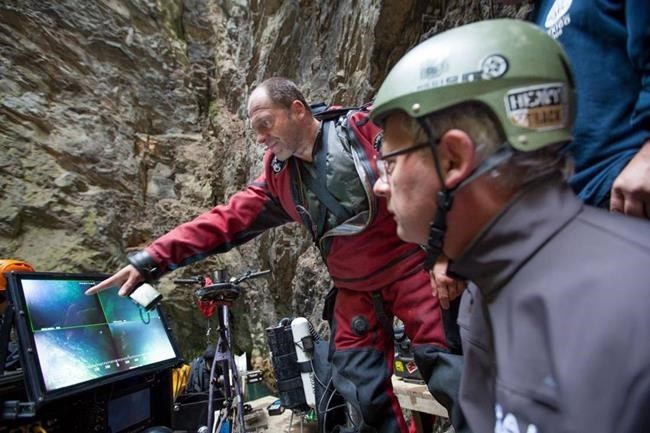
In this photo taken Sept. 27, 2016 in the flooded Hranicka Propast, or Hranice Abyss, in the Czech Republic Polish explorer Krzysztof Starnawski, left, and Bartlomiej Grynda, right, are reading images from a remotely-operated underwater robot, or ROV, that went to the record depth of 404 meters ,1,325 feet, revealing the limestone abyss to be the world's deepest flooded cave, during the 'Hranicka Propast - step beyond 400m' expedition led by Starnawski and partly funded by the National Geographic. (AP Photo/ Marcin Jamkowski)
Republished September 30, 2016 - 5:48 AM
Original Publication Date September 30, 2016 - 12:55 AM
WARSAW, Poland - A team of explorers say they have discovered the world's deepest underwater cave, 404 metres (1,325 feet) down, near the eastern Czech town of Hranice.
Polish explorer Krzysztof Starnawski, who led the team, told The Associated Press Friday he felt like a "Columbus of the 21th century" to have made the discovery.
Starnawski, 48, found the cave Tuesday in the flooded limestone Hranicka Propast, or Hranice Abyss, which he has explored since 1998. He scuba dived to a narrow slot at 200 metres' depth and let through a remotely operated underwater robot, or ROV, that went to the depth of 404 metres.
In 2015, Starnawski himself passed through the slot and went to 265 metres' depth, realizing that was still far from the bottom and that the cavity was widening. After diving that far down, Starnawski spend must spend four or five hours in a decompression chamber. To explore the cave further, he needed a robot.
Speaking on the phone from his home in Krakow, southern Poland, Starnawski said Tuesday's discovery makes Hranice Abyss the world's deepest known underwater cave, beating the previous record-holder, a flooded sinkhole in Italy called Pozzo del Merro, by 12 metres (39 feet.)
The Czech Speleological Society said it thinks the cave is even deeper and will yield additional records.
On Tuesday, when the robot was 404 metres deep, "it was as deep as its rope could go, but the bottom was still nowhere in sight," the society said in a statement.
Diving in the cave is a challenge because of muddy areas and a water temperature of 7 degrees Celsius (44.6 degrees Fahrenheit.) The water's mineral composition also damages equipment and hurts any exposed skin, Starnawski said.
"But that is the only price to be paid for this discovery, and it was worth paying," he said.
On Saturday, he plans to dive to 200 metres again to bring the robot back through the narrow passage. The device was made especially for the expedition and operated by a Polish firm, GRALmarine.
He said National Geographic, which first reported the discovery , covered some 20,000 euros ($22,440) of the expedition's cost.
News from © The Associated Press, 2016